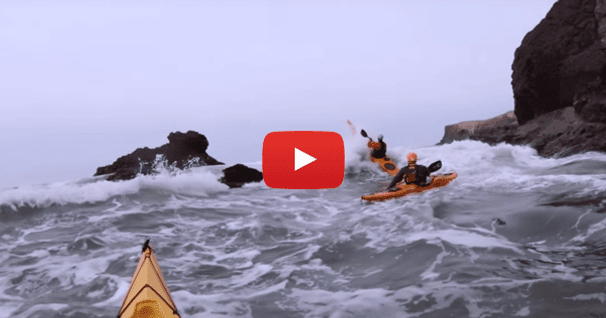Common Beginner Mistakes on SUP
These are some things that almost everybody does wrong in the beginning, so don't feel bad if you do it, but this will help you avoid some of the common mistakes.
First of all, when you go in the water, make sure that you're deep enough in the water where your fin doesn't hit the bottom. I see a lot of people get about this deep, and they put their board down and try to jump on it, and the fin is still stuck in the sand here. So make sure you get the board out far enough in the water where the fin clears the bottom. So once you're out this far, you're far enough out.
So then, try to always get on your knees first before you try to stand up, and make sure you're in the middle of the board. So I'm going to get up on the board on my knees, and you can kneel like this or sit on your ankles, whichever is more comfortable for you. And then, when you're paddling on your knees, hold the paddle lower, you don't have to hold it way up here. And make sure you go into the wind first. That's another common mistake. Don't let the wind just carry you downwind, and then having to struggle coming back.
The next thing is standing up. Don't look down at your feet, try to look forward. That's another common mistake, where people look down and then they just keep falling in because you kind of end up going where you look. If you look down, you're going to go down.
Now also, another thing is holding the paddle correctly, which is with the blade angled forward. Almost all beginners try to hold the paddle backwards. If you do that, you end up pulling your board down. If you look at the angle of the paddle right here, and I'm pushing the water up, I'm pushing myself down. So the correct way is to hold the blade angled forward, paddling like this.
Another common mistake is to have the paddle not straight up and down, but too far out to the side. The more you get the paddle out to the side and away from the board, the more your board's going to turn. So if you want to go straight, you want to hold the paddle straight up and down, and pull it back in a straight line. This is what's going to make your board go straight. The more you have it out to the side, if you want the board to turn, you can do a steering stroke getting the paddle out to the side, getting your body lower to the water, getting the paddle kind of at a low angle, way out to the side, that's what's going to make you turn. You're going straight, you hold the paddle straight up and down.
Okay, another common mistake that we see a lot of beginners do is holding their hands too close together. So if you try to hold your paddle really close together, and try to stroke like this, you'll notice that it's very, very hard to make a stroke and get any power in your paddle. So try to hold the paddle about halfway down the blade. So about halfway between the blade and the handle, that's where your hands should be. If you put it on top of your head, it should be about right angles with your elbows. That's how you get a lot of power on your paddle. Most beginners hold their paddle somewhere around one or two feet down, and it's very hard to get enough power in your stroke at that grip height.
So, what else? Oh, another thing is just not standing in the right spot. A lot of times beginners stand too far back on their boards. So if you're trying to paddle like this, you can see my board's at an angle, and it just kind of drags through the water. It's very hard to get your board moving, plus it's less stable. So try to stand right in the middle, where the board's flat in the water, and you're going to have better glide with your board.
All right? So those are just a few little common mistakes that people make, and just have fun and enjoy.
Related Articles
I am taking a different approach to this year's resolutions. Every year I spend a little time over the…
Ken Whiting answers the big question for new paddlers - Do you go for a canoe, a kayak, or a stand up…
By changing how you edge and balance your boat you can increase your stability and adaptability. Using…
When a situation occurs while paddling in a group, conditions don't stop. Learn some pointers on how to…



